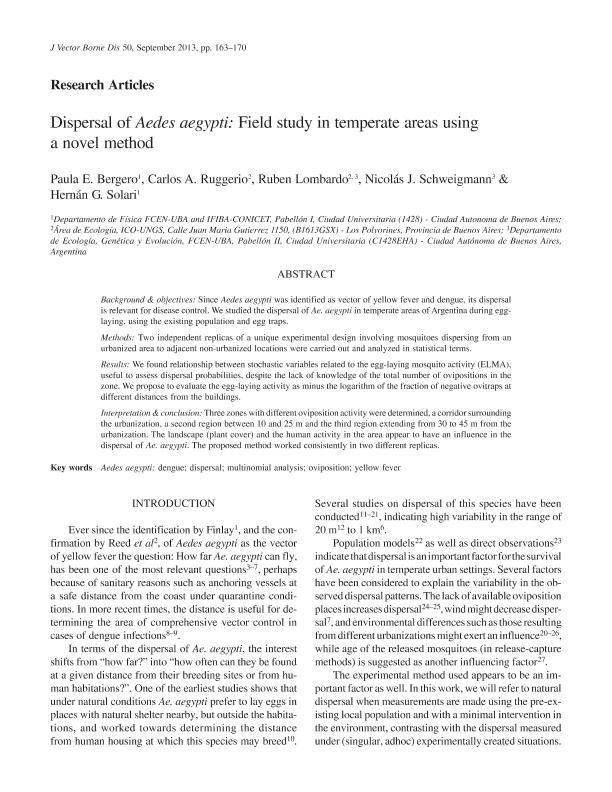Artículo
Dispersal of Aedes aegypti: Field study in temperate areas using a novel method
Bergero, Paula Elena ; Ruggerio, Carlos Alberto; Lombardo Berchesi, Ruben Jorge
; Ruggerio, Carlos Alberto; Lombardo Berchesi, Ruben Jorge ; Schweigmann, Nicolas Joaquin
; Schweigmann, Nicolas Joaquin ; Solari, Hernan Gustavo
; Solari, Hernan Gustavo
 ; Ruggerio, Carlos Alberto; Lombardo Berchesi, Ruben Jorge
; Ruggerio, Carlos Alberto; Lombardo Berchesi, Ruben Jorge ; Schweigmann, Nicolas Joaquin
; Schweigmann, Nicolas Joaquin ; Solari, Hernan Gustavo
; Solari, Hernan Gustavo
Fecha de publicación:
09/2013
Editorial:
Malaria Research Centre
Revista:
Journal Of Vector Borne Diseases
ISSN:
0972-9062
Idioma:
Inglés
Tipo de recurso:
Artículo publicado
Clasificación temática:
Resumen
Background & objectives: Since Aedes aegypti was identified as vector of yellow fever and dengue, its dispersal is relevant for disease control. We studied the dispersal of Ae. aegypti in temperate areas of Argentina during egglaying, using the existing population and egg traps. Methods: Two independent replicas of a unique experimental design involving mosquitoes dispersing from an urbanized area to adjacent non-urbanized locations were carried out and analyzed in statistical terms. Results: We found relationship between stochastic variables related to the egg-laying mosquito activity (ELMA), useful to assess dispersal probabilities, despite the lack of knowledge of the total number of ovipositions in the zone. We propose to evaluate the egg-laying activity as minus the logarithm of the fraction of negative ovitraps at different distances from the buildings. Interpretation & conclusion: Three zones with different oviposition activity were determined, a corridor surrounding the urbanization, a second region between 10 and 25 m and the third region extending from 30 to 45 m from the urbanization. The landscape (plant cover) and the human activity in the area appear to have an influence in the dispersal of Ae. aegypti. The proposed method worked consistently in two different replicas.
Palabras clave:
Aedes Aegypti
,
Dispersal
,
Oviposition
,
Multinomial Analysis
,
Dengue
,
Yellow Fever
Archivos asociados
Licencia
Identificadores
Colecciones
Articulos(IFIBA)
Articulos de INST.DE FISICA DE BUENOS AIRES
Articulos de INST.DE FISICA DE BUENOS AIRES
Articulos(INIFTA)
Articulos de INST.DE INV.FISICOQUIMICAS TEORICAS Y APLIC.
Articulos de INST.DE INV.FISICOQUIMICAS TEORICAS Y APLIC.
Citación
Bergero, Paula Elena; Ruggerio, Carlos Alberto; Lombardo Berchesi, Ruben Jorge; Schweigmann, Nicolas Joaquin; Solari, Hernan Gustavo; Dispersal of Aedes aegypti: Field study in temperate areas using a novel method
; Malaria Research Centre; Journal Of Vector Borne Diseases; 50; 3; 9-2013; 163-170
Compartir



